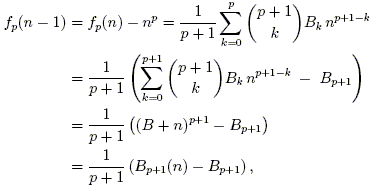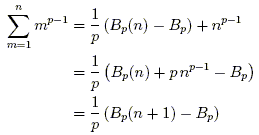We would like to arrive at a computationally simpler formula for the function
 | (1) |
that computes the sum of the first n consecutive like pth powers. Clearly for zeroth powers,
For p = 1, we desire a formula for the sum

of the first n natural numbers. The first few sums are
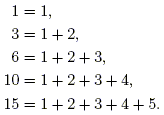
These numbers are known as the triangular numbers because they are the number of dots in the following isosceles right "triangles":

The explicit formula can be obtained by a simple geometric interpetation: The numbers of dots in the triangles are half of the numbers of dots in the following rectangles:

So the nth triangular number is n (n + 1) / 2, and we have the identity

For second powers, there is no obvious geometric interpretation. The sequence begins:
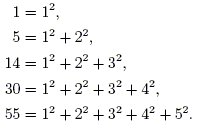
It's not too difficult to guess the correct formula, especially if we suspect that it is given by a polynomial in n, as in the p = 1 case:

In general, we may suspect that the sum of the first natural numbers raised to the pth power is a polynomial in n of degree p + 1. If this is true, then on a case by case basis it is possible to find this polynomial for a given p (for example, by finding an interpolating polynomial to the first p + 2 points). However, it would be more enlightening to find a closed-form expression for the sum fp(n).
Without foresight, one approach to this is the following: Record the expressions for several low values of p and look for patterns. By interpolation, we find:
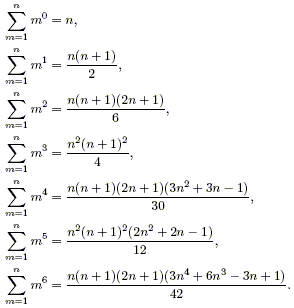
There are no obvious patterns in the larger factors, and the irreducible quartic factor in the formula for p = 6 is somewhat foreboding. Let us change our view of these slightly and look instead at the fully expanded polynomials:

Immediately we notice some patterns: The leading coefficient appears to be 1 / (p + 1), and the coefficient of np seems to always be 1 / 2. By clearing away the variables and putting the coefficients in a table to line them up (ignoring the zero constant term 0n0 in each case), we see some more structure:
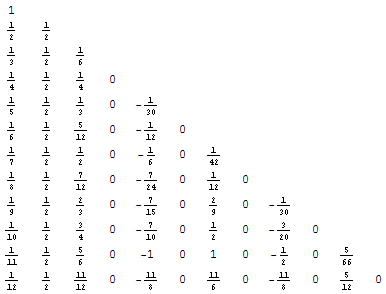
Several columns are simply 0. The coefficient of np – 1 is evidently linear: p / 12. It turns out that the coefficient of np – 3 is given by a cubic in p: –p (p – 1) (p – 2) / 720. In fact, for even k the coefficients of np + 1 – k are given by a fairly simple polynomial of degree k – 1:
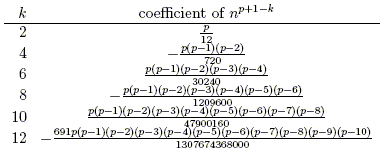
The product ![]() can be written more succinctly as
can be written more succinctly as ![]() , suggesting that we rewrite the above polynomials as binomial coefficients:
, suggesting that we rewrite the above polynomials as binomial coefficients:
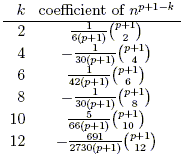
Let Bk be the (signed) constant appearing in the expression for the coefficient of np + 1 – k. Note that the zero columns in the table of coefficients imply that for odd k > 1, Bk = 0. With the exception of understanding Bk, we have arrived at the following conjectural formula for fp(n):

It turns out that the coefficients Bk are simply the Bernoulli numbers:

Furthermore, we can even bring the first two terms into the sum if we include a factor of (–1)k to take care of the fact that B1 = – 1 / 2 while the coefficient of np is 1 / 2:
 | (2) |


